NEONATOLOGY ON THE WEB
Premature and Congenitally Diseased Infants
by Julius H. Hess, M.D.
Part II.
Nursing and Feeding Care
Chapter VII.
Care and Nursing of Premature Infants.
All infants born three weeks or more before full term should be
considered premature and treated as such. Every infant born after the
sixth month should be given an opportunity for life by the
administration of `necessary care and diet. Healthy premature infants
when properly cared for will frequently reach the full development of
the full-term infant by the end of the first year, and the majority
of those surviving usually develop a normal body and mind,
notwithstanding the fact that they are more commonly subject to
megacephalus, rickets, spasmophilia, anemia, gastro-intestinal,
respiratory and circulatory affections, ' all of which can be
overcome without leaving any sequelae, unless based upon some
congenital anomaly.
To be successful with these infants a certain routine must be
followed:
1. Preparation for their home or hospital care must be
made, whenever possible before labor.begins.
2. Their immediate care after birth is of greatest importance.
3. Their general care must be adapted to their individual
needs.
(a) Refrigeration must be prevented.
(b) Skilled nursing is essential.
4. Human milk must be provided for those born before the
thirty-sixth week.
5. The daily routine must be adapted to the infant's age and
development.
6. Contact between the infant and individuals not concerned in
its immediate care must be avoided. Attendants ill with colds and
other forms of infection should observe most rigid rules of
asepsis to avoid cross infections.
PREPARATIONS FOR THE INFANT'S BIRTH.
In case of expected premature labor immediate preparations must be
made for the reception of the infant into a proper environment. The
preparation must not be delayed until labor has begun, otherwise many
viable premature infants will be lost. If the proper facilities
cannot be furnished in the home, the mother should be persuaded to
enter a hospital before confinement. She should be impressed with the
fact that every day of added intra-uterine life will improve the
infant's chances not only for life, but also for normal development.
Preparation for the proper conduct of labor should be complete
whether in the home or hospital. The mother should be prepared with
great care and every effort made to conduct an aseptic labor. The
room should be selected and prepared to meet the needs for labor and
the requirements of the infant. It should be well ventilated and
properly heated to at least 70° F. Blankets and pads into which
the baby is to be received should be warmed. The basket-bed or
incubator-bed should be prepared for its reception by proper
sterilizing and heating, so that all exposure to cold will be
avoided. Everything must be in readiness for the care of the cord,
eyes, mouth, skin and treatment of asphyxia. These should include a
catheter and hot bath, and facilities for transportation of the
infant to a hospital, if necessary.
IMMEDIATE CARE OF THE PREMATURE INFANT.
Asepsis.-The greater susceptibility of the prematures
demands even more painstaking observation of the rules that hold good
for new-born infants in general. These infants succumb more readily
to infection and are much less resistant than are the full-term
infants. Again, the frequently complicated feeding technic gives more
opportunity for disturbances of the digestive tract so that in every
form of indirect feeding careful attention to details must be
insisted upon. Also the danger of infection of the respiratory
passages by careless exposure and aspiration of food are not to be
underestimated.
Reception of the Infant.-A warm sterile pad, towel or
preferably a blanket should be in readiness to receive the infant. As
soon as the head is born the face and eyelids should be gently
sponged with'sterile warm water, and the mucus should be removed from
the air passages by carefully wiping the nose and mouth with a soft
pledget of gauze. The body and cord should be protected from all
contact with feces and other infected matter. After the body is born
the infant should be placed so that the head is dependent, allowing
the mucus and secretions which may have accumulated in the
respiratory passages to escape.
Preservation of Body Temperatures.-The preservation of
temperature demands a very careful supervision immediately following
birth, proper attention must be paid to the thermolability and
tendency to subnormal temperatures. The chief object in the
preservation of the temperature is the prevention of excessive heat
loss, which in itself may be a danger to the infant, This will also
diminish the energy loss. The infant must be wrapped in material with
poor heat conduction, and then placed in a warmed bed. Both are
essential to a successful maintenance of body temperature.
The preservation of heat must be begun immediately after birth of
the infant, preferably on the confinement bed itself, as the extent
of the initial temperature loss is of no mean consequence to a
premature infant. After severing the cord the infant should be placed
in a heated basket or incubator-bed, which should be a part of the
equipment of the delivery-room.
In the home, hot-water bottles, a properly protected electric pad
(p. 224), or an improvised incubator (p. 223) will answer the
purpose. It should be remembered that these infants are easily burned
and such burns are usually fatal.
In small prematures the cotton-pack, completely enveloping the
infant, except for the face and genito-anal region; answers very
well. To the genital region and anus a napkin of cotton or gauze ,
combination may be applied. A jacket may be placed on the outside of
the cotton to hold it in place.
Treatment of the Cord.-The time of tying and section of the
cord will depend entirely on the general condition of the infant and
to some extent on the obstetrician's ability to prevent undue
exposure of the, infant to cold. In the absence of marked asphyxia it
is well to allow the pulsation of the cord to become weakened or to
disappear before ligation. This usually requires from one to five
minutes during which time the infant will receive from 30 to 60 cc of
blood from the placenta. This blood should be conserved, when
possible.
The cord should not be tied too close to the skin. Great care must
be exercised in tying the cord to prevent cutting it in two with the
ligature which is easily accomplished in the premature, therefore it
is always well to leave sufficient space for a second ligature behind
the first in case of an accident.
Asphyxia.-The possibility of asphyxiation of the premature
infant must be borne in mind throughout the entire labor. The heart
tones should be carefully watched and in cases of prolapse of the
cord, if it cannot be successfully replaced, it may be necessary to
induce a rapid delivery of the infant. Any accumulated secretions or
aspirated material must be removed by inversion of the child and if
necessary by aspiration by means of a catheter. In more extreme
degrees of asphyxia early separation of the cord may be necessary so
that artificial respiration and a hot bath may be instituted (p.
244).
The irritation of the catheter in the pharynx will frequently
reflexly stimulate respiration. It should, however, be remembered
that the use of the catheter is not without danger to the operator
because of the frequency of syphilis as a cause of premature birth.
If these procedures fail to bring about the desired result the infant
should be suspended by the feet, the forehead resting lightly on the
bed or table so as to deflect the chin and. straighten out the
trachea and then the chest is compressed between the thumb of the
right hand resting on the back and the four fingers of the same hand
resting on the anterior wall of the chest.
This act should be repeated from sixteen to twenty times a minute
by compressing and suddenly relaxing the chest wall. This should be
continued for at least one minute in severe cases to insure success.
At the same time a nurse or assistant should wipe the excess of mucus
from the nose and throat. The child is then placed in a warm bath
(about 105° F.) for five minutes, and then placed in a heated
bed. In extreme cases the procedure must be repeated. Administration
of oxygen, about 120 bubbles per minute, may be of value, if
administered through a catheter inserted in the mouth or a properly
constructed mask. Careless handling and traumatizing the infant or
too rapid performance of artificial respiration is productive of more
harm than good and must therefore be avoided. There must be definite
indications for all manipulations undertaken. If the infant appears
to be recovering spontaneously it should be left alone.
It must be borne in mind in the conduct of all premature labors
that the anesthetics, if used in labor, tend to weaken the uterine
contractions, thus prolonging labor and favoring asphyxia and a
sufficient quantity of the drug may pass into the infant to seriously
affect it, which is especially true of scopolamine-morphine
anesthesia.
All premature infants whether asphyxiated at birth or not should
be carefully watched for cyanotic attacks during the first days of
life, as such attacks may develop suddenly and without
warning. They may be due to a disturbance in the pulmonary
circulation, to a congenital atelectasis, or to injury of, or
hemorrhage into the respiratory center in the medulla. At other times
they are precipitated by intra-abdominal distention which may
interfere with cardiac or respiratory action. For further discussion
of this condition see Cyanosis (p. 241).
Care of the Mouth and Nose.-Every effort must be made to
avoid trauma of the mucous membranes of the nose and mouth, because
of the danger of secondary infections. Cleansing of the nose should
be done by the use of soft cotton pledgets or applicators. In wiping
out the mouth only soft material is permissible. Much can be
accomplished by facing the child with the mouth downward or
laterally with the trunk elevated, so that the mucus can
gravitate toward the mouth.
Care of the Eyes. -- One per cent silver nitrate solution
or 25 per cent argyrol should be used to prevent ophthalmia
neonatorum. The nitrate of silver solution should be neutralized with
a normal saline solution instilled in the eyes. Not infrequently the
application of silver nitrate will result in some inflammatory
reaction of the conjunctiva in the first six to twelve hours after
its application. This is especially frequent in premature infants and
is usually relieved by the application of cold boric-acid solution to
the lids. It is not to be confused with the more serious specific
ophthalmic which develops on the second or third day. In case of
doubt a microscopic examination of the purulent discharge must be
made. In all cases an old silver nitrate solution which has undergone
decomposition should be avoided, as such solutions are far more prone
to irritate the sensitive conjunctiva.
Care of the Skin and Genitalia.-It is of the' greatest
importance that premature infants shall be handled as little as
possible. And when there is doubt as to the advisability of giving
the initial warm bath, it is best omitted, because of the danger of
causing a collapse. When the bath can -be given without chilling it
is indicated in most infants weighing 1500 gm. or more. In smaller
infants and those showing evidence of atelectasia or asphyxia, it may
be needed to stimulate the respiratory functions. Oiling the body is
unnecessary and is to be avoided. The genitalia should be carefully
cleansed with a boric-acid solution or sterile water without trauma.
The same is true of the buttocks, after which a small pad of cotton
or combination is applied to the genitalia and buttocks.
Dressing the Cord.-Either a dry or alcohol dressing should
be applied. The cord usually dries by mummification and drops off in
most instances by the end of the first week, averaging somewhat later
than in full-term infants. Every precaution should be taken to
prevent trauma of the stump and secondary infection. This applies
more especially to the bathing of the infants in emergencies for
cyanotic spells and hypothermia.
Examination for Congenital Anomalies and Disease.-Before
the infant is left by the physician it should be examined for
congenital anomalies and evidence of syphilis and other diseases.
GENERAL HYGIENE AND ENVIRONMENT.
Requirements of a Hospital Nursery Unit.-This depends
greatly upon the method used for maintaining external heat.
1. Superheated rooms without heated beds.
2. Individual heated beds.
When the superheated rooms are in use separate rooms for
the older and better-developed infants must be supplied to gradually
accustom them to ordinary room temperature. However, this extra room
is not necessary when external heat is applied in individual beds in
which the temperature can be regulated to meet the needs of each
infant. In using the latter the room can be held at a temperature
approximating 70° F. In point of economy of space and special
care for the infant the latter method has every advantage.
When individual heated beds are used the following units are
required in a properly regulated department.
Room Containing Heated Bed.-A room with a south exposure is
preferable. In such a room the matter of ventilation will depend to a
large extent upon the type of heated bed which is used. When the old
type of closed incubator is used, it must necessarily receive fresh
air through a pipe passing through the wall of the building or an
opening in a window, thereby supplying the bed with air from the
outside (Fig. 136). When an' electrically heated bed or home
improvised bed is used the infant is dependent upon the general
ventilation of the room for its supply of fresh air.
Such a room is best constructed with double windows and transom
which can be regulated at will according to the season and existing
weather conditions. Such a system of ventilation should be
sufficiently flexible to permit regulation to meet exigencies which
may arise due to instability of the general heating plant. It has
been our experience that when a well-constructed superheated bed is
used, variations of from 6 ° to 8° F. in the room
temperature during the twenty-four hours cause little inconvenience
to the infant.
It should be remembered that the beds should not be placed in a
direct line of draft between the windows and the doors. The room
should be built or selected with this in mind. Such a room should
also contain a hygrometer and special thermometers which register not
only the present temperature but also the extremes for twenty-four
hours (Taylor Instrument Company). Such a thermometer is one of the
best methods of testing an efficient nursery. Further discussion of
incubator rooms, incubators, superheated beds and similar apparatus
are covered under the special chapter on Incubators.
This room is to be used only for well new-born prematures in their
individual beds and older infants who have been gradually accustomed
to ordinary room temperature.
The Nursery.-The nursery should be a room independent of
the station in which the superheated beds are kept. It should be
provided with double windows, a good system of heating, and must be
kept immaculately clean. Good ventilation and general cleanliness are
essential. Unless a special bathroom can be provided, the nursery
should be furnished with the following equipment.
1. A bathing slab or board. We find a metal jacket which
can be filled with warm water very serviceable (Fig. 64). The
Divan bath with thermostatic mixing valve is well designed for
this' purpose.
2. A heated dressing table provided with cabinets for storing
and warming clothes.
3. Supply closets for linens.
4. A well-constructed balance scale graduated to 4 gm.
5. A hygrometer (Figs. 69 and 70).
6. Thermometers registering the present and extreme
temperatures for twenty-four hours (Fig. 70).
7. A time clock should also be provided and all feedings
registered by this method, so that the supervisor may have a
constant check on the activities of her assistants.
The general hygiene and care of the infant in the nursery is
second only in importance to an ample supply of human milk and a
maintenance of the body temperature of the infant.
Milk Stations.-A milk station for preserving and dispensing
breast milk and artificial diets should be a part of the equipment of
every general and special hospital (Fig. 72).
Wet-nurses' Quarters.-Wet-nurses' quarters should provide
living and sleeping-rooms for the wet-nurses and their babies. The
ideal requirements for such a unit are described under the chapter on
Wet-nurses, p. 117.
A shower bath and toilet facilities should be provided for the .
special use of wet-nurses but not in living quarters.
SPECIAL QUARTERS FOR SICK INFANTS.
It is of the greatest importance that infected premature infants
be grouped according to their ailments and that complete facilities
for caring for these infants be established, in order to avoid cross
infections. Two such units should be provided whenever it is expected
that a considerable number of premature infants are to be cared for,
and should include facilities for bathing, feeding, and the general
care of patients. Gastro-intestinal and respiratory infections must
be kept separated and treated as septic cases. Syphilitic infants and
cases of gonorrheal ophthalmia must also be provided with separate
quarters. Thrush and furunculosis which frequently develop into
severe types should also be isolated.
Aseptic nursing is imperative to the welfare of the
department. Soiled. linens, clothes, bottles, thermometers and all
other utensils must be handled as infected material.
A complete department should therefore provide for:
A. Well Infants.-A room containing heated beds for the
early care and cribs for graduates. The further needs are:
A heated dressing table, a supply closet, thermometer
(high and low), hygrometer, time clock, electric heater for
emergency, screens and a lavatory.
A nursery with bathing facilities, supplied with: A bath slab,
a lavatory, a heated dressing table, shelves for toilet articles,
a gas or electric plate, an electric heater for emergency, a
scale, thermometer, supply closet.
A special bath-room when possible should be provided so that
bathing in the nursery may be avoided.
Quarters for wet-nurses with independent bath and toilet
facilities, equipped with: Beds, cribs, chiffoniers, dressing
table, nursery chairs and lavatory. The bath room should have a
shower bath, dressing room, toilet and lavatory.
A milk station containing a sink, refrigerator, work table,
tubs for washing utensils, steam sterilizer, bottle and food
racks.
Nursing staff including a directing nurse and assistants.
Wet nurses.
B. Infected Infants.-Room equipped with heated beds and
cribs and provided with bathing facilities. This room should further
contain a lavatory, heated dressing table, scale, thermometer,
hygrometer, emergency electric heater, supply closet and screens. The
bath tub in this room may be of the small ambulatory type or of the
Divan slab type. Both may be easily sterilized.
The nursery should be considered as the center of the unit
and when a separate bath room is provided, the former may be used for
housing the graduates. The temperature of this room should range
between 78 and 80° F. during the hour of bathing, at other times
70 to 75° F. The entire station must be thoroughly cleaned at
least every second day and disinfected by scrubbing immediately after
the diagnosis and removal of infectious cases.
The Nursery Staff.-The selection of a personnel for the
nursing staff of a unit established for the care of premature infants
requires great care. Nurses assuming these responsibilities must be
intensely interested in their work. They must be willing to make many
necessary sacrifices while the infant is passing through the critical
stages. They must, at all times, be prepared to meet the emergencies
of asphyxia and to counteract the spells of cyanosis. These two
factors in themselves require almost constant diligence, otherwise
the work of previous days will go unrewarded. They must use good
judgment to prevent over- and underfeeding, as to a very great extent
the size of the individual meal will be dependent upon the physical
condition of the infant at the time of feeding. In no other class of
patients is it so necessary to change or modify on short notice
previous orders for diet. The nurse must know the indications for and
the methods of administering catheter feedings, colonic flushing,
tubbing and the application of artificial respiration.
In our hospital wards we have found the constant changing of
nurses, as is so frequently the case in meeting the curriculum for
nurses' training in general hospitals, to be of the greatest
disadvantage. Far better results are obtained when the nurse in
charge has under her care assistants who need not necessarily be
nurses in training, but preferably young women who are especially
preparing themselves for the care of young infants, and who can be
relied upon to stay in the station for long periods of time. Such
women become expert in the handling of these infants, can frequently
feed them with a minimum of excitement of their reflexes, and soon
learn to bathe and give them their exercise and massage, which is so
essential to every infant in order to prevent "hospitalization."
The ideal nursing staff for such a station is, therefore,
one consisting of a well-trained supervising nurse and a corps of
assistants desiring this training, and who are willing to remain in
this service for a long period of time.
DAILY ROUTINE.
Removal of Infants from Their Beds.-The position of the
infant in bed should be changed at regular intervals. The removal of
infants from their beds should be practised with forethought. The
small infants should, so far as possible, be manipulated only upon a
definite indication: (1) For cleanliness, including bathing; (2)
exercise, including gentle massage after the first week or two. In
most instances the food, when administered other than by catheter,
can be given without removing the baby from the bed. Catheter feeding
in infants not subject to cyanotic spells can often be performed to
advantage without removal from the bed. When cyanosis is present or
easily precipitated the infant should be removed from the bed during
feeding.
In preparing the infant for permanent removal from the
heated bed the room temperature should be gradually lessened until
70' F. is approached.
Next the infant is placed in an infant's crib, the sides of which
have been padded to prevent extreme currents of air from coming in
contact with the infant and thereby increasing radiation. These cribs
may remain in the same. room as the individual heated beds, or may be
kept in the nursery if it be the more desirable room of the two, when
there is a separate bath room. The infant should not be kept
permanently in a room in which a considerable number of infants are
being bathed throughout the day. There is no need for shortening the
stay of the infant in the heated bed if the temperature of the
surrounding air is gradually being lowered as the infant. develops.
Depending upon the age and development, the average length of time in
a heated bed varies from one to six weeks. It is good practice to
place the older infants in the crib during the day and to replace
them in the heated bed during the night when the heating of the house
or ward is uncertain.
The Bath.-In the very weak infants it is frequently
advisable to omit the first and the daily bath for two or three days.
It may, however, be necessary to use the warm bath to stimulate the
infant during its cyanotic attacks.
It should be a fixed rule in the care of premature infants to
handle them as little as possible, because of the danger of provoking
cyanotic attacks and the regurgitation of food. It should be our
object to keep the skin clean and active. The practice of oiling the
infant as a routine measure is to be avoided. If the bath cannot be
undertaken without danger of chilling the infant, it should be either
dispensed with or postponed for a more opportune time; or a partial
bath may be given without removing it from the heated bed by washing
the face, buttocks and genitalia.
Indications for and Methods of Administering Baths. -- The
earliest baths should consist of a sponging with water at 105°
F., one part of the body only being exposed at a time to prevent
chilling and the process carried forward as rapidly as possible in a
room of not less than 75° F., otherwise it is best omitted in
the very small infants.
As infants grow older they may be dipped in or sprayed with water
heated to 100° F., and this may be gradually lowered to 95°
F.
Under no circumstances should the infant be bathed without first
taking the temperature of the water and the room.
Infants with subnormal temperature may frequently be stimulated
and the temperature raised by placing them in a warm bath which is
held between 103° and 106° F.
In cases of hyperpyrexia a bath from 4° to 5° lower than
the infant's temperature with cold to the head is of therapeutic
value.
In the presence of cyanotic attacks the plain warm bath or weak
mustard bath with slight friction repeated as indicated are probably
the best therapeutic measures. During such attacks the infant should
be handled gently as not infrequently careless and rough handling
will result in death during these cyanotic attacks.
All bathing before separation of the cord should be carried out
with the idea of promoting surgical cleanliness.
Gentle friction and light massage are of great value following the
bath. Neither of these methods of stimulating the circulation must be
overdone. Bathing should always be done before feeding.
Care of the Eyes.-If properly cared for at the time of
delivery and if there is no reaction to the solutions used at that
time, they require no further attention except ordinary cleanliness.
The nurse should be warned against getting bath water, or more
dangerous, mustard water in the eyes. In cases of ophthalmia the
treatment is practically that as used for full-term infants with
greater care for the prevention of trauma and destruction of the eye.
The Nose and Mouth.-Unless there is a direct indication due
to plugging of the nose or an infection of the nose and mouth, there
should be no manipulation of these mucous membranes, because. of the
danger of abrading them and opening fresh surfaces for infection. In
the presence of upper respiratory tract infections or stomatitis, the
greatest care should be taken in applying local treatment as advised
in the special chapter dealing with these diseases.
The use of the nasal catheter is always a dangerous procedure and
even the passing of the catheter through the mouth may result in
trauma if not carefully performed.
The Breasts.-In simple mastitis the breasts should be
anointed with camphorated oil and a light pad of cotton held in place
by a snug breast binder. The dressing may be changed every second,
third or fourth day as indicated. In case of abscess formation, which
is of very infrequent occurrence in prematures, incision and drainage
should be performed.
The Genitalia.-The genitalia more especially the vulva in
girls should be handled with extreme care in order to avoid trauma
and infection. Small cotton combination pads should be applied to the
buttocks and genital organs in order to receive the feces and urine.
They should be frequently changed in order to avoid irritation from
the excreta. By the use of these small pads which are described under
the chapter on clothing, the frequent change of diapers can be
avoided.
When there is evidence of infrequent or painful urination, which
is more especially true in a male infant, it should be immediately
inspected for evidence of occlusion due to the drying of secretion or
exudate in the presence of an ulcer at the meatus. The buttocks are
easily irritated by the decomposing urine and acid stools, and these
parts readily become infected. In most instances the napkin can be
changed .without removal from the bed. In the treatment of all
lesions about the genitalia an attempt should be made to keep the
parts dry and clean. If water proves irritating a starch water may be
substituted or the parts may be cleansed with benzoated lard. The
parts are then dusted with stearate of zinc or rice starch. When
these simple methods fail, a 1 per cent mixture of balsam of Peru in
castor oil or lanolin maybe used. Our best results have been obtained
in older infants when the buttocks are exposed to warm dry air
through the medium of an incandescent electric light or sunlight if
the latter is possible without the danger of chilling the infant. In
small prematures the parts may be left uncovered in the heated bed.
Small rolls of cotton may be used to separate the folds of the skin.
The present-day use of washing powders, which are retained in
improperly rinsed diapers and which lead to a rapid decomposition of
the urine, may be a source of intertrigo.
Delayed urination is not infrequent and should lead to an
inspection of the genital organs. A delay of twenty-four hours in the
passage of the first urine is quite common in premature infants. If
the infant is otherwise apparently normal, it should not be a cause
for too great concern, and it is to be remembered that a small
quantity of colorless urine may dry out and go unobserved. The best
treatment is the administration of fluids approximating one-twelfth
to one-twentieth of the body weight of the infant during the first
day or two, and later approximating one-sixth of the body weight.
This is inclusive of all fluids administered. A warm moist pad over
the lower abdomen and pelvis or a warm bath will frequently cause
spontaneous urination.
Uric-acid crystals and urates are very commonly found in the urine
of the premature causing a pinkish stain on the napkin and are most
commonly due to marked concentration of the urine. At autopsy,
however, more frequently than in the full term, do we find these
salts deposited in the kidneys. Considerable pain may be caused by
the passage of these deposits through the ureter. In every case
fluids should be pushed.
The Bowels.-The anus should be carefully inspected shortly
after birth to ascertain the presence or absence of anomalies. Delay
in passing the first stool may be due to one of many causes, such as
delayed peristalsis, weak abdominal wall, contracted sphincter and
accumulation of feces, most commonly in the sigmoid or cecum.
We believe it is a good custom to attempt to promote a bowel
movement before the beginning of milk feedings. Frequently the.
administration of inert fluids per mouth will promote peristalsis. We
do not hesitate to give a 1- or 2-ounce normal saline colonic
flushing. The amount used depends upon the development of the infant.
A small glycerin or soap suppository answers. If there remains doubt
as to the patency of the intestinal tract, a small dose of castor
oil, 0.5 to 1 cc (8 to 15 drops), may be administered per mouth. Once
the patency of the intestinal tract has been established, intestinal
evacuations are usually spontaneous, more especially so with infants
fed on breast milk or with high carbohydrate mixtures. For
further. treatment see Constipation.
Care of the Skin.-The skin of the premature is very
delicate and covered with lanugo and prominent sebaceous glands.
There is a great tendency for the skin to dry and crack and to
desquamate in large flakes. This is especially true in infants
suffering from marked jaundice. There is also great tendency for
papular, vesicular and pustular eruptions of various types to
develop. Erythematous eruptions are of frequent occurrence. All of
these conditions will call for a modification of the daily routine,
insofar as the baths and local skin care are concerned. The greatest
danger is due to secondary skin infections which is especially true
of the syphilitic infant. The various forms of dry treatment of these
lesions offer the best results with the least danger of spreading.
The application of silver nitrate to. each pustule and vesicle after
cleansing with alcohol have given us the best results, except in the
case of syphilitic infants where local mercurial treatment is
indicated.
The daily care of the skin should therefore consist of the
avoidance of trauma and exposure to secondary infections in the
bathing and handling of the infant, the removal of all excretions,
the separation of-irritated folds by a layer of cotton, and the dry
treatment of all non-suppurating skin lesions, and antiseptic
treatment, cauterization or specific treatment of open lesions.
Delayed Separation of the Cord.-Delayed separation of the
cord may be hastened by the application of 5 per cent silver nitrate
solution or 50 per cent alcohol dressings. In the use of the latter a
few drops of alcohol may be applied to the dressing at regular
intervals. When the hard, dry cord remains intact far beyond the
usual time for separation it may be necessary to cut through the
remaining strands, using great care to avoid the live tissues.
Granulations are best treated by the application of silver nitrate
solution or hard stick.
Body Temperature.-The body temperature must be taken
through the rectum. It should be recorded morning and evening. An
individual thermometer should be furnished for each infant.
Fluctuations in body temperature are more marked than in the full
term infant with a tendency toward hypothermia. A minimum of
97° F. should be considered the lowest compatible with progress.
Attempts should be made to limit the daily fluctuations to 1.5°
F.
Subnormal temperature may result from undue exposure at birth,
subsequent carelessness, lack of development of the nervous system,
absence of a good layer of subcutaneous fat, respiratory
insufficiency circulatory weakness and insufficient heat production
due to lack of food or defective metabolism.
These etiological factors are to be counteracted by definite
therapeutic measures.
Prevent undue exposure and trauma from the moment of birth. The
infant should be placed in a heated bed of proper construction and
kept there under constant supervision. The temperature of the heated
bed should be varied with the needs of the individual infant. Small
prematures and congenital weaklings with marked hypothermia should
temporarily have a surrounding temperature varying from 85° to
95° F. Older and stronger infants are better placed in a bed at
75° to 80° F. As the infant develops its vital functions
and the subcutaneous fat increases, the temperature of the bed should
be gradually lowered to that of the nursery, which should be kept at
about 70° to 75° F. It should be the rule to regulate the
temperature of the heated bed by the rectal temperature curve, and
while it may be impossible to bring the body temperature to normal,
the degree of hypothermia is our best guide in the application of
external heat.
It may be necessary to place the infant in a hot bath to raise the
temperature and stimulate respiratory and cardiac function following
syncope.
Removal from the bed should follow definite indications, ordinary
feeding, changing napkins and the ordinary routine measures can be
carried out in the bed.
The body must be insulated by proper clothing to be described. The
body fluids, after the first few days, must be maintained by an
intake of from one-sixth to one-eighth of the body weight in fluids
in twenty-four hours, and this must include a caloric intake of more
than a sustaining diet, 70 calories per kilo after the first ten days
of life (p. 180).
Respiratory and circulatory functions must be protected and at
times stimulated.
Hyperpyrexia frequently results from an overheating of the
bed, and when a high temperature is noted the temperature of the 'bed
should be considered as a possible cause.
Infections of all kind tend to the development of fever, but on
the whole ,the reaction is less than in the full term, however, the
exception may be true. We have found massive pneumonias at autopsy
which were unassociated with temperature above the average normal.
The Pulse. -- The pulse may be imperceptible in the
extremities and require auscultation of the heart for timing. The
cardiac action will usually. range from 100 to 180 per minute in the
small and weak infants, although occasionally a very slow pulse is
noted, which latter usually precludes a bad prognosis. The best
indicator of proper cardiac function is the infant's general
circulatory condition; it gives far more information than the number
of heart beats.
Respiration.-The respirations normally vary from 20 to 60
per minute in different infants and are to a large extent dependent
on the heart action in infants not suffering from atelectasis or
central disturbances. During cyanotic attacks they become almost
imperceptible and may be temporarily suppressed. Again the general
condition of the infant is the best guide.
Weighing should be done at a specified time each day as
part of the general routine, with a good scale. The infant should,
unless contraindicated, be undressed for this purpose, and this is
best done before the bath. The relation between the time of the last
feeding and passing of feces should be noted.
In older well infants daily weighing may not be indicated but in
prematures it should be done as a routine, more especially in
difficult feeding cases. Those fed at the breast must be weighed
before and after nursing, and the food taken is to be recorded.
Loss of Body Weight during the First Days of Life.-This
occurs almost constantly in premature infants, the percentage loss
being greater in the premature than in the full-term infant, and, on
the whole, they are much slower in regaining their birth weight. In
the group of cases studied by the author the average loss in the
cases weighing between 1000 and 2000 gm. was 10.9 per cent. More
recently we have been able to reduce the initial loss to
approximately 5 per cent in a number of cases by carefully increasing
the fluid intake after the first twelve hours.
Most of our cases have regained their birth weight by the
eighteenth to the twenty-first day, with a daily gain averaging from
12 to 40 gm. after reaching their lowest weight, which is usually
about the fifth day. Infants under 1500 gm. may be considered as
progressing satisfactorily on an average of from 10 to 20 gm., and
doubling their birth weight in seventy-five to one hundred days; and
those from 1500 to 2000 gm. when they are making a daily gain of from
15 to 25 gm. after they have reached or passed their birth weight
with a doubling of that weight in from fifty to one hundred days.
The Infant's Clothes.-The wardrobe should be planned and
completed in advance of labor. In emergencies this may not be
possible. It is imperative to remember that preservation of the body
heat must be begun immediately after birth; on the confinement bed
itself. Insulation of the body is the prime thought to be borne in
mind when planning the wardrobe. The clothes must fit the body
snugly, providing only for a thin layer of air between the body and
the dress. The material must be selected with some knowledge of the
method by which external heat is to be supplied. The head, except the
face, and the extremities must be equally protected with the body.
At birth the infant is received into a warm blanket and
immediately placed in a heated basket, heated bed or incubator.
In supplying external heat it should be remembered that these
infants are easily burned, and such burns are usually fatal.
In small prematures for temporary emergency use a sterile
cotton-pack which completely envelopes the infant, except for the
face and gentao-anal region, may be applied. It should, however, be
remembered that cotton is far inferior to wool in prevention of heat
radiation. An improvised jacket, preferably of flannel, may be placed
oil the outside of the cotton to hold it in place.
To the genital region and anus an easily changed small pad of
cotton or gauze combination may be applied. Whenever the infant
becomes soiled, it is only necessary to change the pad. This should
not be neglected.
If special outer garments are not available, the infant should at
once be wrapped in a small heavy woolen blanket, or cotton
combination, which can be fastened about the body loosely by bandages
or safety-pins in papoose fashion. The greatest disadvantage of such
a dress is the limitation of body movements, which is of considerable
importance even in these infants. All pressure and constriction must
be avoided (Figs. 75, 76 and 77).
In a well-equipped station several sets of special cloths should
be provided. These should be kept sterilized in packets. The outfits
will differ somewhat, depending upon whether the open or closed
incubator beds are used.
With the open type of heated beds, all garments next to the
body, except the napkins, should be made of light-weight flannel.
A set of clothing should consist of woolen bands of small size;
small woolen undershirts; overshirts; pinning skirts; woolen
stockings; diapers; pads; bibs; and a woolen bag, with an attached
head-piece, with a slit over the upper part in front to allow passing
over the head. The bag should be open at the bottom to allow of its
being raised for changing of napkins, dressing the cord and general
care of the infant (Fig. 77). The overskirt should be somewhat longer
and larger than the undershirt and may to very good advantage be made
from French pique which is less impervious to air than flannel.
In the absence of a sleeping bag the infant may be wrapped in a
light flannel blanket, so applied that the upper part will form a
hood.
With the closed type of bed, the sleeping bag and blanket
are unnecessary.
A complete outfit for use with an open bed should contain:
Four bands 12 inches long and 4 inches wide (flannel or
knit wool).
Four undershirts with blind sleeves and draw string at neck
(flannel).
Four overshirts (flannel or French pique fleeced).
Four pinning skirts (French pique 24 by 28 inches).
Two bags with hoods 30 inches long and 20 inches wide (woolen).
Or two blankets 1 yard square (flannel, knit wool or cashmere).
Four pairs of stockings (woolen).
Two dozen diapers size 18 by 20 inches (fine bird's eye).
Small genital pads (absorbent cotton and gauze).
Bibs (same material as jackets).
How to Dress the Baby.-The clothes must be put on quickly
without undue exposure. First, the abdominal band is applied, if
needed to retain cord dressing, otherwise it may be omitted, then the
undershirt, followed by the overshirt, both of which are pinned at
the side, next the small genital pads and diapers, to be followed by
the pinning blanket, the latter being turned up over the feet and
pinned at the back.
The infant may then be placed directly in its bed and its head and
body covered by a blanket, or it may be put in one of the woolen bags
before being put in its bed. The selection of the last article of
dress will depend largely on the condition of the infant.
The essentials of the dress are:
1. Good insulation.
2. Cleanliness.
3. Protection from changes in temperature.
4. Ease of application and removal with a minimum manipulation
of the infant.
In the emergency and in very small and weakly infants these
indications may be met temporarily by a complete envelopment in
cotton, but as soon as safe and convenient the infant should be
dressed in the simple and easily applied garments described. These
garments are so applied that they may be described as upper and lower
garments. For the changing of soiled napkins the upper half of the
clothes need not be removed. Complete undressing is required only for
the purpose of bathing.
Many of these little infants vomit repeatedly and if it were. not
for the heavy texture of bib and jacket, it would necessitate very.
frequent complete undressing of the infant, instead of removal of the
soiled linen only, which is but part of his dress. These clothes are
easily ironed. Absorbent cotton can be used as a bib. We also provide
for fresh bedding preferably by the use of untarred jute in our bed
and pillows, if the latter are used, which can be thrown away at will
because of its cheapness.
The infants should be watched very closely and the wet and soiled
linen changed immediately to prevent intertrigo, as the urine dries
very quickly in the heated bed and when concentrated erodes the skin,
which is severe and disastrous to these children. After each change
the infant should be carefully cleansed, either with water, benzoated
lard or mineral oil, before being replaced in the heated bed. The
clothes should fit snugly and are to be preheated before applying and
must be absolutely dry. This especially applies to diapers. In
laundering the baby's clothes no bluing, lye or strong alkaline soaps
should be used, the best for this purpose being a neutral or nearly
neutral soap of the type of which Ivory soap is an example. The
clothes should then be rinsed in pure water before drying.
The child should not be wiped with the soiled diaper, but with
absorbent cotton which can then be destroyed. The same should apply
for bathing purposes, where cotton is far more cleanly than a sponge.
Arranging the articles on and in a heated dressing table expedites
dressing the infants with the above style of dress. The child can be
dressed in one or two minutes without undue manipulation.
Watch for Sickness.-The possibility of grave pathological
changes with minor clinical manifestations must be constantly borne
in mind in the care of prematures. In order to diagnose and properly
counteract the dangers which may follow the overlooked simple
ailments, at least one daily general inspection and examination,
quickly but carefully performed, is required. The exception to this
rule is the immediate danger due to handling extremely delicate
infants.
In no other group of infants is a careful study of the individual
functioning of the heat centers and the respiratory,, circulatory,
nervous, genito-urinary and gastro-intestinal organs so imperative.
The Hospital Records.-The records should include the.
following forms'
1. A history and physical examination blank (Fig. 85).
2. A graphic record chart (Fig. 86).
3. A special feeding card for recording the amount of
individual feedings and stamped by the time clock. Time of
urination and stools and a description of the latter can be
recorded on this same card. Inspection of the infant at feeding
times will prevent neglect in changing the infant and assist in
the prevention of local and ascending bladder infections. The data
from the feeding card should be transposed to the graphic record
sheet daily (Fig. 87).
4. Temperature chart for room and bed. On this sheet is
recorded the temperature of the bed in which the baby is kept. It
should be charted at six-hour intervals, best at 6 A.M., 12 M. and
6 and 12 P.M. These are the most likely times for maximum changes
in the ward temperature which might call for an increase or
decrease in the external heat to be applied to meet the desired
bed temperature. At the same time the ward temperature should be
recorded and the humidity in the room and bed should be noted and
recorded (Fig, 88).
5. Physician's order blank (Fig. 89).
6. Milk station order blank (Fig. 90).
7. Wet-nurse's record blank (Fig. 91).
The Clinical Record.-A careful history is most important,
as much evidence which will have a direct bearing on the prognosis
will frequently be elicited as well as suggestions for feeding and
therapy. The maternal history as to illness, previous pregnancies and
their outcome must be elicited. The paternal history is. Also of
prime importance. The presence or absence of acute illness in the
home, more especially whooping-cough, scarlet fever, diphtheria and
septic infections should be investigated before the infant is
discharged.
Every hospital record should show the data of at least two
social-service investigations. This, while usually neglected,
frequently reveals conditions in the home which make the early
discharge of these, retarded infants impossible, if their lives are
to be conserved.
The first investigation should be made in the shortest time
possible after the infant enters the hospital, the last just previous
to the infant's discharge.
Conserving the Mother's Breasts,-If the mother does not
accompany the infant she should be encouraged to conserve her breast
milk. This may be accomplished by one of several methods: (1) By
expression at regular intervals, and if this is the method used she
should be encouraged to send her milk, to the hospital once or twice
daily, if for no other reason than to keep a record of her
faithfulness. (2) By nursing a neighbor baby, one loaned to her from
the hospital or some other source. Later by having her come to the
institution to nurse her own or a full-term hospital baby. (3) By
placing a puppy to her breasts. While this latter at first thought
may seem repulsive, it has in our own experience proved to be a most
desirable expedient.
REQUIREMENTS FOR THE CARE OF PREMATURE INFANTS IN THE
HOME.
The establishment and maintainance of properly equipped hospital
stations are essential to the lowering of mortality, more especially
in the large cities and particularly among the poorer classes. A
careful consideration of the requirements for and results to be
expected from their care in the home is equally essential.
In many instances the premature is born unexpectedly with little
time for preparation for its reception. The expectancy of a-premature
labor is almost always associated with more or less excitement in
which thought for the baby's needs are likely to be overlooked, the
mother usually being given first consideration.
It will, therefore, be our object to outline a proper routine for
the establishment of an emergency home unit.
In the home care of these infants the same rules for hygienic
maintainance of body temperatures, breast feeding, and daily routine
must be maintained as suggested for their hospital care.
The Nursery Unit. -- Whenever possible two rooms should be
set aside for the infant's use; one equipped as a nursery with
furnishings similar to those described for the hospital nursery. The
second room is to be used for sleeping quarters and must be equipped
with a heated bed. These rooms must be well ventilated and at the
same time well heated. In both these rooms all draperies and
unnecessary furniture must be removed.
A bath room properly equipped (Fig. 92) makes a splendid second
room in which the general care of the infant can be administered.
This room should be given over to the exclusive use of the infant.
When such a bath room is available only one other room is needed.
When the baby is being dressed or bathed the nursery or bathroom
temperature should be in the neighborhood of 80° F. A gas or
electric stove will be of assistance in accomplishing this. When a
superheated bed is in use the sleeping room may be kept between 70 to
75° F. All visitors other than the attendants and physician
must be excluded.
The equipment of the room or rooms should include a heated bed, a
dressing table, preferably heated, or placed over a warm radiator, a
small electric or gas stove for emergency use, a scale, bathing and
feeding utensils, a thermometer, a hygrometer and surgical supplies
(Fig. 93).
The Superheated Bed. In the home hot-water bottles, a
properly protected electric pad or an improvised incubator will
answer the purpose (p. 223).
A thermometer should be placed alongside the baby as too great
emphasis cannot be laid on the dangers and fatalities due to
overheating and burning of prematures. There is a great tendency to
hyperthermia which must be recognized and properly interpreted. There
is usually a rapid return to normal body temperature without bad
effects upon removal of the cause unless too long continued. The
general care of the heated bed has been described on p. 218.
The Nurse. -- She must be experienced in the feeding and
handling of such infants and must be tireless in her efforts to
prevent complications. She must be diplomatic in order to permit the
overcoming of the mother's anxiety, with its consequent effect upon
her milk secretion. he must be able to control the habits of the
wet-nurse, if one is employed. he must insist upon taking orders from
the physician and no one else. She must be able to keep a careful
record, practise aseptic nursing, avoid accidents and be cleanly in
her personal habits.
A second person should be present, who can assist and relieve the
nurse. She must be willing to work under the nurse's supervision. uch
a person is indispensable in the presence of emergency. Only those
directly interested in the care of the baby should come in contact
with it.
The Infant's Food.-Breast milk should be considered
indispensable and during the first days of life it may be necessary
to obtain a temporary supply from a neighboring mother, a wet-nurse
or a hospital. A small amount, 90 to 240 cc daily will usually meet
the emergency. nly when these sources of supply fail absolutely
should artificial feeding be instituted.
Preparation for Labor.-The protection of the infant must
begin with the first stage of labor. The room, receiving clothes and
its bed must be properly warmed. Refrigeration is the direct cause of
more deaths among prematures than any other extraneous factor. All
routine measures described for the hospital care in Chapter VII
should be, so far as possible, observed in the home.
Clothes. -- The clothes best suited have been
described. Simplicity in dress with is minimum manipulation or
changing being the object to be attained, because or the dangers of
exposure, trauma and infection. The infant should be received into
warm blankets. One of the most; common errors is to allow the infant
to remain in such a loosely applied robe, which does not provide for
proper insulation of the skin because of the large air space between
the blanket and the infant. This allows rapid radiation of the body
heat. Therefore, at the earliest possible moment the infant should be
protected from head to foot by closely applied warm clothes. The
body, if woolen clothing is not at hand,, should be wrapped in
cotton. The cotton should be applied in two parts, the upper half
encircling the head except the face, together with the trunk and
upper extremities, the lower half should encircle the lower
extremities, a small pad being applied to the genitalia and buttocks.
This allows for cleansing the genital region with a minimum of
manipulation. The upper part of the body may then be covered by a
small-sized infant's shirt on the outside of the cotton jacket and
the infant is then wrapped in a woolen blanket in its bed. The
clothes best adapted for later use can be made according to the
description on page 155, and should be supplied as soon as possible.
A woolen blanket should cover about three-quarters of the basket, the
head being left open.
The Bath.-The advisability of giving a warm bath has been
discussed but it is our desire to emphasize the conclusion that the
initial bath is to be omitted whenever there is danger of unduly
exposing the infant. In a proper environment the warm cleansing bath
should be given in the absence of cardiac and respiratory
complications.
Further Early Care.-The baby must, under all circumstances,
be under constant observation during its first hours because of the
dangers of cardiac and respiratory complications, over- and
underheating, overcovering, and overlying, the latter due to careless
placing of the infant in the bed. Whenever feasible the infant should
be placed in a properly prepared room away from the mother. Its
personal attendant, other than for special care, need not necessarily
be a trained one. When a dependable person is not at hand it should
be kept in the room with the mother.
The general care should be that as described for hospital
care.
The Results Obtained.-With human milk, a skilled nurse, an
adequate bed, a good nursery and proper feeding and nursing technic
the same good results are to be expected as in hospital care.
Transportation to a Hospital.-Removal to a hospital station
should not be delayed when nursing and feeding needs cannot be
fulfilled in the home. It should be moved in a specially prepared bed
so that it will not be exposed en route. When the infant is to
be sent to the hospital which is provided with a transportation
incubator, the institution should be called upon to transfer the
infant.
|
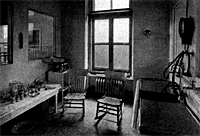
|
Fig. 64.-Hospital bathroom, located between two small
wards for infants, showing two metal water jackets resting
on a porcelain sink. These can be filled with water and have
a registering thermometer for indicating the temperature
before giving the. bath. They are covered with a clean towel
for each baby. Baby is showered from an automatic mixing
tank which registers temperature of the water in the tank.
The room further contains a scale and a low dressing table
with the various dressings, powders and ointments to be
used. Also low nursery chairs, collapsible bags for soiled
linen and waste basins.
|
|
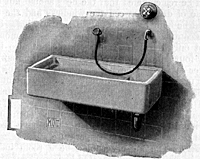
|
Fig. 65. Divan bath with thermostatic mixing control.
|
|
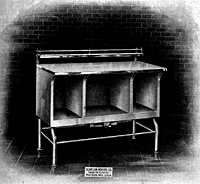
|
Fig. 66. Electrically warmed dressing table. (DeLee.)
|
|
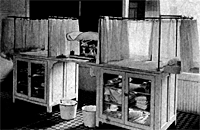
|
Fig. 67. Large unheated dressing table, provided for
dressing of two babies. Scale in center and closed cabinet
for clothes. (Couney.)
|
|
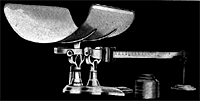
|
Fig. 68. Scale for weighing infants.
|
|

|
Fig. 69. Thermometer registering present and
extreme room temperature during the twenty-four hours. It is
to be adjusted by a small magnet once daily.
|
|
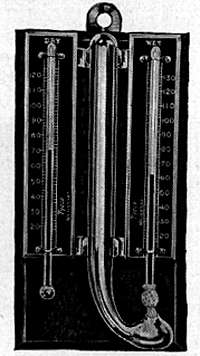
|
Fig. 70. Hygrometer. Wet and dry bulb.
|
|
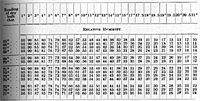
|
Fig. 71. Humidity table for use with wet and dry bulb
hygrometer.
|
|
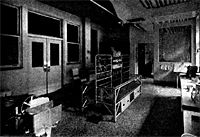
|
Fig. 72. A milk station consisting of three rooms. Room
1.-For all used bottles, bottle washers and steam bottle
sterilizers. Room 2.-A clean room for preparation of
formulae. This room also contains milk separator, fat
testing apparatus and butter churn. Room 3. -- Pasteurizing
and sterilizing apparatus.
|
|
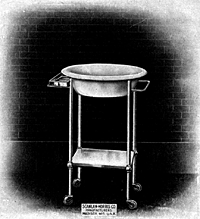
|
Fig. 73.-Portable bath basin for individual
use of infected infants. Basin can be removed for
sterilization.
|
|
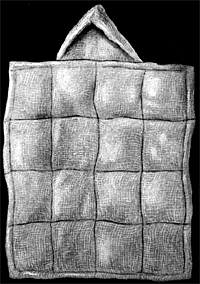
|
Fig. 75. Emergency robe with hood made of gauze and
cotton combination.
|
|

|
Fig. 77. Woolen bag with hood. For further protection it
may be drawn together beneath the infant's chin.
|
|

|
Fig. 78. Wool flannel undershirt with closed sleeves.
|
|
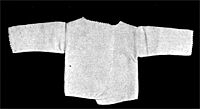
|
Fig. 79. Heavy overshirt made from French pique.
|
|
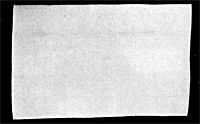
|
Fig. 80. Pinning skirt or blanket for the lower half of
the body. (Made from French pique.)
|
|
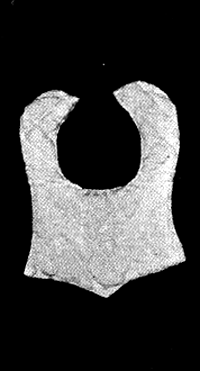
|
Fig. 81. Bib.
|
|
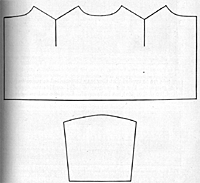
|
Fig. 82. Pattern for designing under- and overshirts.
Diagram of body and sleeve patterns.
|
|

|
Fig. 83. Dressing the baby. Under- and overshirts
applied.
|
|

|
Fig. 84. Dressing the baby. Under- and overshirts and
pinning shirt applied.
|
|
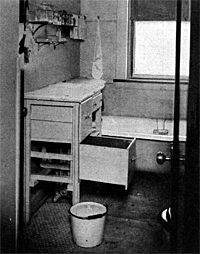
|
Fig. 92. Special bath room equipment for private home,
showing dressing table (padded) with drawers, built over
radiator. Shelves for dressing, etc., above the table.
Bathing board over one end of bath tub.
|
|
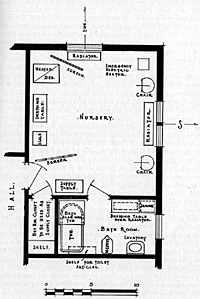
|
Fig. 93. Plan for arrangement of stations in a private
home, consisting of one large, well ventilated and heated
room and a bath room.
|
Return to the Hess Contents Page
Created 10/4/2002 / Last modified 10/4/2002
Copyright © 2002 Neonatology on the Web / webmaster@neonatology.net




















